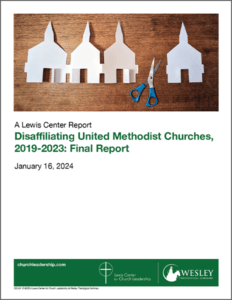The recent disaffiliation process in the United Methodist Church leaves in its wake grief, hope, and many unanswered questions regarding the impact of prior unifications, the impact of clergy and judicatory leaders in the process, and the various motivations for disaffiliation. Lovett H. Weems of the Lewis Center staff raises some of these significant questions and identifies areas where qualitative research is needed as the church strives to move faithfully into the future.
Researchers have much with which to work in answering the many questions raised by the experience of the United Methodist Church from 2019 through 2023. If past divisions are predictive, there will be a host of partisan narratives. What will be most needed are objective scholars who can go beyond statistical data to representative surveys and qualitative research to answer some of the questions presented below, as well as many others.
Did some congregations not fully embrace prior unifications?
The two regional jurisdictions with proportionately more disaffiliations than the denomination as a whole are the Southeastern and South Central Jurisdictions. Together these jurisdictions accounted for 71 percent of disaffiliating churches. Prior to disaffiliations, the two jurisdictions contained 52 percent of churches. The Southeastern Jurisdiction and the South Central Jurisdiction (minus Kansas and Nebraska) constitute the dominant territory encompassed by the former Methodist Episcopal Church, South, prior to denominational reunification in 1939.
Similarly, the membership of the former Evangelical United Brethren Church, when they and The Methodist Church formed the United Methodist Church in 1968, was heavily concentrated in states where some conferences had disaffiliation rates higher than other conferences in their jurisdictions and higher than the denominational average. These conferences are East Ohio and West Ohio, Indiana, and Western Pennsylvania.
Further investigation is required to learn if there is more than coincidence with disaffiliation rates and prior affiliations of congregations. If a connection is found, the question becomes whether there are ways in which the distinctive cultures of those involved in a unification could have been maintained more effectively in the new entity. This devaluing of what were experienced as significant elements of the prior affiliations of congregation may well have contributed to some disaffiliations.
What issues motivated disaffiliations?
The paragraph through which churches could disaffiliate between 2019 and 2023 restricted the reason for leaving to the one issue of conscience regarding human sexuality. This was obviously the presenting issue facing congregations, though the factors behind each disaffiliation seem more complex than one issue. While it may be true that most disaffiliating churches were composed of members with similar views on homosexuality, that appears not to have always been the primary or only motivation behind formal disaffiliation. After all, churches staying often represented congregations in which views on sexuality and other controversial issues vary. Those involved in congregational conversations about disaffiliation report several motivating factors:
- Property ownership. “This is the last chance you will ever have to own your property,” was an argument suggested in some churches.
- Real estate value. As one lay person argued in a meeting, “Where can you get $1.5 million in property for $25,000?” (i.e., that congregation’s financial responsibility should they leave)
- Pastor’s preference. For some pastors the motivation was theological, while others wanted more control of the congregation and their own future. In a few cases, this became a way to avoid mandatory retirement at 72.
- Reliance on misinformation. A part of the disaffiliation movement was the distribution of misinformation by bodies that sought to benefit from this division.
- Polity. Some United Methodist churches surrounded by churches with congregational polities see greater independence as preferable to more connection.
- Disconnection with denomination. Through a variety of factors such as policy differences, feelings of neglect and poor pastor assignments, some churches have long since lost their loyalty to the denomination.
- Apportionments. Removing the annual expense of apportionments influenced some.
What difference did bishops make?
Bishops took different stances regarding disaffiliation. On the one hand, a few bishops appeared to use their office to encourage disaffiliations rather than supporting the unity of the United Methodist Church while still active bishops. On the other hand, a few bishops were seen by some as using their influence with pastors and conference policies to make disaffiliations more difficult. Most bishops were seen trying to maintain a strong United Methodist witness consistent with their episcopal office while fairly implementing the actions of General Conference.
What difference did pastors make?
Similarly, pastors took a range of positions regarding disaffiliation in principle and in relation to their congregation’s decision making. The information or misinformation pastors provided to their congregations was often a significant factor, including the selection of resource persons to provide information to church members. It is also clear that some pastors viewed their own futures yoked to the outcome of the disaffiliation vote.
What role did retired pastors play in disaffiliation?
Some retired pastors were serving churches dealing with disaffiliation while others were participants in congregations and had many connections across their conferences. In some cases, retired pastors worked at odds with the pastor of the church they attended. One example is a retired pastor who handed out pro-disaffiliation literature as people left church in a congregation with little interest in disaffiliation. Another retired pastor began a new congregation for members dissenting from a church’s decision to remain in the United Methodist Church. Some active and retired pastors who support the disaffiliation movement have kept their own clergy credentials within the United Methodist Church, causing some to question their intentions.
Why are so many disaffiliating churches not joining another denomination?
One stark difference seen between disaffiliating churches and similar departures from other mainline denominations is the decision of disaffiliating churches to remain independent of any denomination, at least for now. Most of those departing other mainline denominations joined another denomination immediately. Similarly, in the 1844 Methodist division, those leaving moved at once to another body, the Methodist Episcopal Church, South. It appears that only about half of disaffiliating churches are joining another denomination, but no one knows for sure.
Why did some conferences have virtually no disaffiliations?
Some conferences had no disaffiliations — or only a few. There are likely varied reasons. It is clear that both race and region mattered in the propensity of churches to disaffiliate. However, we know from public surveys that disagreements around human sexuality are present in varying degrees across most regions and races. Was it conference disaffiliation policies that made the difference? Or had some conferences already experienced prior disaffiliation not by churches but by members because of conference policies on sexuality issues?
Why are disaffiliating churches so overwhelmingly white?
Among all racial and ethnic groups represented in the United Methodist Church, differences regarding human sexuality issues persist. In light of that reality, why would so few churches other than majority white churches disaffiliate?
Why did so many pastors of disaffiliating churches withdraw themselves from the United Methodist Church?
In the disaffiliating process, there is not a necessary connection between a congregation disaffiliating and a pastor leaving the denomination. In fact, some had assumed more pastors would stay and projected that more pastors would need appointments than there would be churches remaining in some conferences. There are likely many reasons pastors have left, some theological and others, personal, such as having more control over their futures. More study is needed to understand the factors.
Was there a reflection of the polarized society at play?
Some have speculated that the timing of disaffiliation could not have been worse given the polarized politics of the United States. Some argue that many people who traditionally would not have been attracted to a secession movement now could see disaffiliation as a natural next step to their support of a particular political direction.
 Related Resources
Related Resources
- Disaffiliating United Methodist Churches, 2019-2023: Final Report by Lovett H. Weems Jr.
- Disaffiliating Churches through June 2023 by Lovett H. Weems Jr.
- Disaffiliating Churches through 2022 by Lovett H. Weems Jr.
If you would like to share this article in your newsletter or other publication, please review our reprint guidelines.







